In Norse mythology, Snotra is a goddess associated with wisdom. Snotra is attested in the Prose Edda, written in the 13th century by Snorri Sturluson, and in the Gautreks Saga, where she is the mother of Gautrek son of Gauti, the eponymous ancestor of the Geats, and Goths, a son of Oðinn as King of Sviþjoð. Scholars have proposed theories about the implications of the goddess.

Hrólfr Kraki, Hroðulf, Rolfo, Roluo, Rolf Krage was a semi-legendary Danish king who appears in both Anglo-Saxon and Scandinavian tradition.

The Ynglings were a dynasty of kings, first in Sweden and later in Norway, primarily attested through the poem Ynglingatal. The dynasty also appears as Scylfings in Beowulf. When Beowulf and Ynglingatal were composed sometime in the eighth to tenth centuries, the respective scop and skald (poet) expected his audience to have a great deal of background information about these kings, which is shown in the allusiveness of the references.
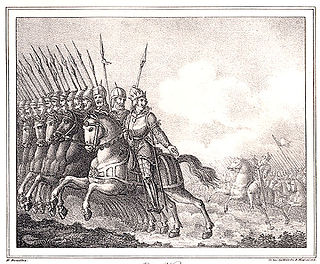
Eadgils, Adils, Aðils, Adillus, Aðísl at Uppsölum, Athisl, Athislus or Adhel was a semi-legendary king of Sweden, who is estimated to have lived during the 6th century.

Ingjald illråde or Ingjaldr hinn illráði was a semi-legendary Swedish king of the House of Ynglings, son and successor of King Anund, and the father and predecessor of King Olof Trätälja. As with many of the 5th-7th century Yngling Kings of Sweden, his historicity is contested.
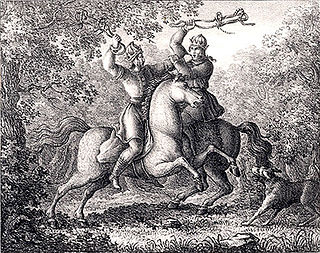
Alaric and Eric, according to legend, were two kings of Sweden.

Halfdan was a late 5th and early 6th century legendary Danish king of the Scylding (Skjöldung) lineage, the son of king named Fróði in many accounts, noted mainly as the father to the two kings who succeeded him in the rule of Denmark, kings named Hroðgar and Halga in the Old English poem Beowulf and named Hróar and Helgi in Old Norse accounts.

Halga, Helgi, Helghe or Helgo was a legendary Danish king living in the early 6th century. His name would in his own language (Proto-Norse) have been *Hailaga.
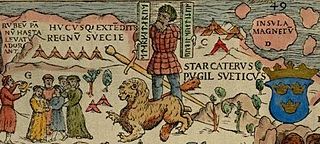
Starkad was either an eight-armed giant or the human grandson of the aforementioned giant in Norse mythology.
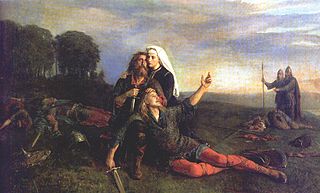
A legendary saga or fornaldarsaga is a Norse saga that, unlike the Icelanders' sagas, takes place before the settlement of Iceland. There are some exceptions, such as Yngvars saga víðförla, which takes place in the 11th century. The sagas were probably all written in Iceland, from about the middle of the 13th century to about 1400, although it is possible that some may be of a later date, such as Hrólfs saga kraka.

Geatish kings, ruling over the provinces of Götaland (Gautland/Geatland), appear in several sources for early Swedish history. Today, most of them are not considered historical.
Gautrekr was a legendary Geatish king who appears in several sources, such as Gautreks saga, Hrólfs saga Gautrekssonar, Bósa saga ok Herrauðs, Ynglinga saga, Nafnaþulur and Af Upplendinga konungum.
Bósa saga ok Herrauds or Saga of Bósi and Herraud is a legendary saga, relating the fantastic adventures of the two companions Herraud and Bósi. It is first attested in three manuscripts from the 15th century, AM 343 a 4to, AM 577 4to, and AM 586 4to.
Víkar was a legendary Norwegian king who found himself and his ships becalmed for a long period. To raise a wind, a human blood sacrifice was needed, and the lots fell on King Víkar himself. Starkad (Starkaðr), Víkar's counselor urged a mock hanging from a tree instead, but in giving this advice Starkad had been prompted by the god Odin, who desired Víkar's death. According to the account in Gautreks saga, when Starkad let loose the branch, the apparent reed-stalk with which Starkad stabbed at the king was seen to be a real spear, the stump under Víkar's feet fell away, and the calf guts which had been used instead of rope turned into a strong withy. Víkar died. Saxo Grammaticus in Gesta Danorum refers to a similar version relating a magic transformation, but prefers or invents a more rational account in which Starkad tied the osier very tightly so that Víkar could hardly breathe and then stabbed Víkar with his sword. This was the first of Starkad's three great crimes.
Hrólfs saga Gautrekssonar is a Scandinavian legendary saga which was put to text in Iceland in the 13th century. It has a prequel in Gautreks saga.
Hrólfs saga kraka, the Saga of King Rolf Kraki, is a late legendary saga on the adventures Hrólfr Kraki, a semi-legendary king in what is now Denmark, and his clan, the Skjöldungs. The events can be dated to the late 5th century and the 6th century. A precursor text may have dated to the 13th century, but the saga in the form that survived to this day dates to c. 1400. Forty-four manuscripts survive, but the oldest one of them is from the 17th century, although a manuscript is known to have existed c. 1461 at the monastery of Möðruvellir in Iceland.
Hrólfr Gautreksson was a legendary Geatish king who appears in Hrólfs saga Gautrekssonar and probably in Hyndluljóð.
Helga þáttr Þórissonar is a þáttr or short legendary saga found within the Saga of Ólaf Tryggvason in the Flateyjarbók.
Eddica minor. Dichtungen eddischer Art aus den Fornaldarsögur und anderen Prosawerken. is a German-language book of Eddic poetry compiled by Andreas Heusler and Wilhelm Ranisch in 1903. Unlike the Eddic poetry published in the Poetic Edda, the poems in Eddica minora were extracted by the authors mostly from the Legendary sagas.
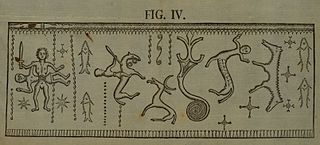
In Germanic heroic legend, Elgfróði (Elk-Fróði) is the half-man, half-elk elder brother of the hero Bödvar Bjarki and Thorir Houndsfoot. The name is also used to describe mythical creatures with his perceived form, which have been seen as a Norse variant of a centaur, although it is not clear if he was intended to be depicted with two or four legs.










